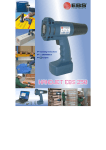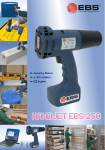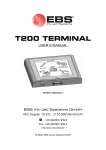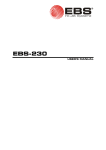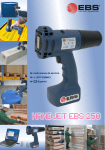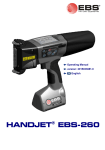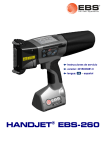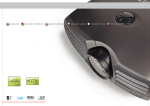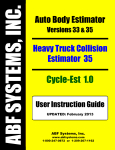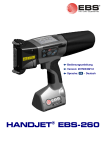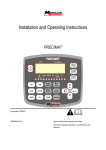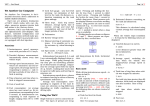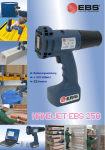Download EBS250 HANDJET - User's manual (ver - barcode
Transcript
Operating instructions v. 20050316#1.0 EN English A 22 17 POWER CHARGE PRINT ON / OFF 18 21 ERROR F 20 19 9 10 11 1 13 2 14 3 4 12 5 8 6 16 15 7 B C 23 26 25 15 27 24 2 16 EBS Ink-Jet Systems 20050316#1.0 D 29 30 USB 28 23 E 11 13 31 33 32 30 34 20050316#1.0 EBS Ink-Jet Systems 3 Components of the Portable Printer System EN See figures A B C D E F . 1. Upper guide roll. 2. Nozzle shield. 3. Nozzle plate - front part of the print head (ink outlet). 4. Lower guide roll, to synchronise printing. 5. Openings with plugs for adjusting electromagnets. 6. Release - a printing release button, also used by other functions. 7. Printer base, battery compartment. 8. Printer holder. 9. Hanger. 10. Control panel and keypad. 11. Ink container. 12. Ink container label. 13. Container OPEN-CLOSED indicator. 14. Name plate. 15. Battery charge socket. 16. Charge plug. 17. Power LED indicator. 18. PRINT ON/OFF LED indicator (the print state). 19. PRINT ON/OFF button. 20. Function key F. 21. Error LED indicator. 22. Charge LED indicator. 23. RFI Module - for wireless (radio) communications via USB interface. 24. Socket to connect cable from the computer communications port. 25. Radio transmission LED indicator. 26. Power pack to charge printer batteries or power supply RFI module 23, with RS-232 interface. 27. Plug of power pack 26. 4 EN 28. Cable for series communication between computer (USB port) and RFI module. 29. Computer. 30. HANDJET EBS-250 Printer. 31. Non-return valves in the ink container and ink system. 32. Guide bayonets in the ink container. 33. Ink container gasket. 34. Seal to protect the ink container. Buzzer - a buzzing signal 35. generator, located inside element 8 of the printer. Signs ! Information signs indicating: 6 that the actions described need to be taken with extra or special care, 6 the printer’s additional or specific functions or options, which are not described anywhere else, 6 untypical behaviour of the printer and other hints. ! A warning not to perform the operation that might be unsafe or critical for the printer. It requires the user to follow closely the instructions given therein. A B C Figure numbering notation The meaning of LED and other indicators: The lamp glows The lamp flashes EBS Ink-Jet Systems POWER CHARGE PRINT ON/OFF ERROR F Buzzer 20050316#1.0 PRINT ON/OFF F PRINT ON/OFF F 3 sec. 3 sec. PRINT ON/OFF button (19) should be pressed for a short time (<1 sec) F button (20) should be pressed for a short time (<1 sec) PRINT ON/OFF button (19) should be pressed for a longer time (>3 sec) F button (20) should be pressed for a longer time (>3 sec) Editing markers: Font change marker - brown Beginning-of-monospaced-text marker (inserts F1) and end-ofmonospaced-text (inserts F2) - red Editing markers: Variable field - incremental counter (inserts Shift+F1) - blue Variable field - decremental counter (inserts Shift+F2) - green Variable field - universal date and time (inserts Shift+F12) - turquoise Wraparound marker - green A marker white in colour means that the cursor is just on the left of the marker (it can be deleted with the BackSpace key). F Text edit window Control Program MENU Transmission and error status window Parameter tab window 20050316#1.0 Printer communication window EBS Ink-Jet Systems Special register and text library window EN 5 EN TABLE OF CONTENTS COMPONENTS OF THE PORTABLE PRINTER SYSTEM.................................... 4 SIGNS ....................................... 4 OPERATIONAL SAFETY ......... 7 EN GENERAL SAFETY INSTRUCTIONS............. 7 PROTECTING THE BATTERY PACK ............ 8 WHEN INK OR WASH-UP SPILLS ............... 8 CONTROL OF ELECTROMAGNETIC INTERFERENCE ....................................... 8 MEDICAL EQUIPMENT .............................. 8 Pacemaker.......................................... 8 Other medical equipment.................... 9 OPERATION IN EXPLOSION HAZARD AREAS .................................................... 9 OPERATION IN AREAS OF BLASTING.......... 9 APPLICATION .......................... 9 INSTALLING AND STARTING UP .......................... 9 PREPARING THE PRINTER FOR OPERATION ........................................ 9 CHARGING THE BATTERY ........................ 9 LOW-BATTERY INDICATOR ..................... 10 INSTALLING AND REPLACING THE INK CONTAINER ...................................... 10 INSTALLING THE INK CONTAINER IN THE PRINTER ........................................ 10 HOW TO CHECK WHETHER THERE IS ANY INK IN THE INK CONTAINER? ........... 10 REPLACING THE INK CONTAINER ........... 11 REGULAR TEXT ..................................... 12 Maximum Print Height ...................... 13 Using and Changing Built-in Fonts of the Printer ..................................... 14 Using and Changing Windows® Fonts ................................................. 14 VARIABLE FIELDS .................................. 15 Date and Time .................................. 15 Universal Date and Time .................. 16 Object Counters ................................ 17 PRINT PREVIEW .................................... 18 HOW TO MODIFY PRINT PARAMETERS ..19 Number of nozzles ............................ 19 Character Resolution ........................ 19 Intensity of Ink Drops ........................ 19 Mode of Timing ................................. 19 Inverting and Reversing a Text ......... 19 Repeating a Text (Repetition)........... 20 Print Delay ........................................ 20 Distance between Texts ................... 21 Printer Travel Rate............................ 21 HOW TO TRANSFER/SAVE TEXT FILES TO/IN THE PRINTER ....................21 HOW TO CHANGE A TEXT FILE STORED IN THE PRINTER .....................22 PRINTING ................................22 REMOVING AND INSTALLING A NOZZLE SHIELD .................................22 PRINTING A TEXT FILE SAVED IN THE PRINTER............................................22 LINE PRINTING ...................................23 USING A NUMBER OF TEXTS ................23 SWITCHING THE PRINTER ON ................ 11 SWITCHING THE PRINTER OFF ............... 11 CREATING A TEXT LIBRARY IN THE PRINTER ............................................... 24 QUICK SAVING/RETRIEVING TEXT FILES TO/FROM THE TEXT LIBRARY ........ 24 PRINTING TEXT FILES FROM THE LIBRARY ............................................... 24 SAVING THE PROJECT LIBRARY ON A COMPUTER DISC .................................. 25 INSTALLING AND STARTING THE PRINTER CONTROL PROGRAM ............ 11 MAINTENANCE, STORAGE AND TRANSPORT ..................25 SWITCHING THE PRINTER ON AND OFF ................................................. 11 INSTALLING THE CONTROL PROGRAM .... 11 STARTING THE CONTROL PROGRAM ...... 12 CONNECTING THE PRINTER WITH A COMPUTER (VIA USB INTERFACE) ...... 12 TEXT FILES AND PRINT PARAMETERS ....................... 12 HOW TO CREATE A TEXT TO BE PRINTED? ........................................ 12 6 EN USER SUPPORT .....................26 PROBLEMS WITH FUNCTIONING AND OPERATION OF THE PRINTER ...............26 Some of the nozzles do not jet ink.... 26 Rinse the nozzles ............................. 26 The printer does not print.................. 26 Boldfaced or Blurred Prints............... 26 QUESTIONS AND PROBLEMS ...............26 EBS Ink-Jet Systems 20050316#1.0 ELECTRONIC GUIDES .......................... 26 CONNECTING THE PRINTER TO A COMPUTER (VIA RS-232 INTERFACE).. 27 TECHNICAL PARAMETERS.. 28 PRINTER ACCESSORIES ..................... 30 Dear User, In order to get full information on how to operate your Ink-Jet Printer, please read these Instructions carefully. As the scope of delivery depends on your order, therefore it may happen that the deliverables differ slightly from some descriptions and illustrations. As we need to keep pace with new technological advancement and our customers’ specific requirements, we reserve the right to introduce changes in the form, design and technical solutions adopted. In view of the above, no data, illustrations or description contained in these Operating Instructions shall make grounds for any claims. Should your Ink-Jet Printer be equipped with options that are not illustrated or described in the Instructions or should you have additional queries after having read the Instructions, please contact any representative of EBS Ink-Jet Systems for more information. ! EBS Ink-Jet Systems, the manufacturer, shall not be responsible for damages to the device due to the operation that is inconsistent with the Operating Instructions or due to consequences of drafting or printing errors in these Instructions. The printer control program to be installed on your computer is a versatile tool for operating EBS-200 series stationary printers and EBS 250 series manual printers. Therefore some of its components and functions which (i) are used exclusively for EBS-200 series printers or (ii) could be used in EBS-250 series printers but are of little significance for manual printers, will not be described in these Instructions or will be described only briefly. Operational Safety ! Before you start your printer for the first time read the hints given below and follow the underlying principles for your own and other persons’ safety. General safety instructions 1. The device must not be operated in rooms where explosion hazard exists. 2. No prints can be made on objects whose temperature exceeds 100°C at the time of printing. 3. No open fire or spark producing devices or objects are allowed in the area where the device operates. 4. During printing ink drops invisible to people’s eye are jetted out of 20050316#1.0 5. 6 the head at pressure. Do not aim head outlet 3 at any persons, animals or casual objects because they may get splashed with ink unintentionally. The following requirements need to be met when washing, cleaning and maintenance operations are performed or ink containers are replaced: The operations can only be performed in a workplace that is especially designed for that purpose, when the device is switched off and protective clothing is worn. A fire extinguisher designed to extinguish electrical devices and flammable solvent fires must be placed within easy reach of the device. Air ventilation needs to be ensured at the workplace. EBS Ink-Jet Systems EN 7 EN WARNING: The ink is inflammable! 6 6 EN 6 6. 7. Be careful not to splash the ink. Especially eyes need protecting. It is advisable to wear protective glasses. Protect the ink and the solvent (also waste fluid remaining after the printer has been washed) against fire, high temperature, sparks, electric arc and other electric discharge as they may cause ignition of these inflammable fluids! Do not use plastic vessels to do the washing. Metal vessels are recommended. Protect the printer against dirt, heavy dust and excessive moisture. EBS-Ink-Jet Systems is able to ensure perfect and safe operation of the printer only when original, printer-specific accessories and consumables are used. Protecting the Battery Pack The following principles need to be obeyed to protect the batteries that are built into the printer: 6 Protect the printer against excessive temperature and fire. Do not expose it to strong solar radiation for a longer time. 6 Avoid a sudden change in temperature (cold Æ hot) that might cause vapour condensation inside the printer and thereby speed up battery discharge and electronic circuit corrosion. Condition the printer for about 1 hour before use after it has been moved from a cool place to a warm one. When Ink or Wash-up Spills 6 Should the eyes or skin get irritated with ink or wash-up: ! 6 6 EYES rinse the eyes with running water for at least 15 minutes, then see your oculist. SKIN wash the skin with water and soap. If the clothing has been splashed, take it off as soon as possible. When ink or wash-up spill, wipe out the spilled fluid with a piece of absorbent material, and then remove the material in compliance with fire and health and safety-at-work regulations. Control of electromagnetic interference 1. Properties of high-frequency devices. Your Ink-Jet printer contains a highfrequency transmitter and receiver. When it is in the ON state, the printer receives and transmits high-frequency (HF) signals. The controller of the Ink-Jet printer system controls energy emitted during printer operation on an on-going basis. The HANDJET EBS-250 printer complies with all the requirements of the regulations concerning the impact of the HF energy on humans in your country. 2. Printer accessories. If you do not use original EBS parts or printer accessories, including batteries or electronic components, the statutory requirements may not be met and the HF electromagnetic emission limits may be exceeded. Medical equipment Pacemaker Pacemaker manufacturers recommend that the distance between a 8 EN EBS Ink-Jet Systems 20050316#1.0 transmitter and the pacemaker be at least 15 cm so that any mutual interference between the two devices is avoided. Other medical equipment If you use a piece of medical equipment, please ask the equipment manufacturer whether the equipment is sufficiently shielded against electromagnetic radiation. In certain circumstances your doctor may help you gain the information you require. Operation in explosion hazard areas If you work in an explosion hazard area, switch your Ink-Jet printer off, do not replace the batteries or do not remove them from the printer and follow all instructions and precautions. Sparking generated by batteries may cause an explosion and/or fire in this hazardous area and result in personal injuries or even death. The regions where a potential explosion hazard exists are usually marked appropriately. The examples of such regions are: solvent storage areas, fuel storage areas and petrol stations, below-decks onboard ships, storage areas for explosive gases, air mixtures, chemicals and metal or flour powders. Operation in areas of blasting In order to avoid interference during blasting (shot firing) the printer should be switched off in blasting areas or in places where the use of radio devices is prohibited. Follow the operating instructions and information signs. ling, putting prints and simple graphics wherever the use of a manual labelling device is required or preferred. Prints are put on objects in a noncontact INK-JET way. Installing and Starting up Preparing the Printer for Operation Charging the Battery A LI-ION top-quality battery has been installed in the printer. It can be recharged at any stage of printer operation. The battery that is new or has not been used for a long time cannot be charged up to its full capacity. Therefore, in order to form the battery follow three charge-and-then-discharge cycles. See figures 1. 2. 3. 4. 5. A and C . Pull out plug 16 from socket 15 and tilt it. Insert power pack connector 27 to socket 15, and connect power pack 26 to a wall outlet. Lamp 22 glows when the battery is being charged. Wait until the charging is over and lamp 22 starts flashing. Remove the power pack plug 27 and secure socket 15 with plug 16. Detach the power pack from the mains and place it into the bag. Do not recharge the battery until it is completely discharged - see Low-battery indicator. Application The HANDJET EBS-250 printer is designed for marking, label20050316#1.0 EBS Ink-Jet Systems EN 9 EN ! The battery is not replaceable as standard. When the battery is charged, the printer cannot communicate with the computer but the printer can be used for printing at that time. 4. Low-battery indicator EN POWER CHARGE PRINT ON/OFF F Installing and Replacing the Ink Container E. Installing the Ink Container in the Printer When the printer is delivered, the ink container is detached. Follow the steps below in order to install the container: 1. Remove the container from packing 11. 2. Remove seal 34 carefully from container 11, so that no leftovers remain on the container shoulder close to gasket 33. 10 EN Position the container in relation to the back of the printer so that three bayonets 32 of the container aim at guide holes of the container connector. At that moment arrow 13 indicates the OPEN position. Insert bayonets 32 into the guide holes and while pressing the container against the printer turn it clockwise, so that arrow 13 is in the CLOSE position. ERROR The printer indicates the low-battery condition with a buzzing signal from and flashing lamp 22: buzzer 35 6 Short-time, regular flashes mean that the battery is almost discharged, the printer can still be operated, 6 Uniform blinking means that the battery is almost completely discharged. In this condition any further operation may be discontinued because the printer can switch off automatically. Recharge the battery. See figure 3. How to Check Whether There is any Ink in the Ink Container? When the printer stops printing make sure that there is no ink in the container. You can assess the ink level in the container in three ways: 1. Weigh the printer on installing a new container - write down the weight. When the container is empty, the weight of the printer is smaller by: 6 about 83 grams - for a 110 ml container. 2. Detach the full container from the printer, place it with its bayonets 32 up into a vessel whose diameter is slightly greater than the diameter of the container and pour water so that the container starts floating without turning upside down. Mark the water level on the vessel before (line 1) and after (line 2) the full container has been immersed. Then insert the empty container and mark the immersion level (line 3). You can check the ink consumption level at any time by immersing the container in water and comparing the current level with the previous lines (lines 2 and 3). Make sure there is always the same water level in the vessel (line 1). EBS Ink-Jet Systems 20050316#1.0 2 full ink container 5. empty ink container Installing the Ink Container in the Printer. 3 1 3. All ink drops jetted are counted and the printer uses the result to evaluate ink consumption. In order to get access to the ink level while the printer is on, click the key in the control program window. Then the control program communicates with the printer and displays the approximate ink consumption level (as a percentage) in container 11 in the Ink level box of the Parameters 3 tab in the control program window. Replacing the Ink Container If possible, replace the container in dustfree conditions so as to minimise the amount of contaminants getting in to the printer’s ink system. not leave the printer with the ! Do ink container detached for a longer time than that required to replace the container. While detaching or installing the container be careful not to splash anyone or anything with ink. See figure E. 1. the 2. 3. 4. Turn off - see Switching the Printer Off. Turn the empty container 11 counter clockwise, so that arrow 13 is in the OPEN position. Pull out the container carefully towards the back of the printer. If gasket 33 and contact plates in the guide holes for two lower bayonets are dirty, remove ink 20050316#1.0 printer leftovers from them with washup. Install a new container - see Switching the Printer On and Off See figure A. EN Switching the Printer On PRINT ON/OFF Press key 19, , and while holding it down press release button 6. When the printer is switched on, lamp 17 glows and a sound signal is heard . from buzzer 35 Once the printer has been switched on, you can start printing a text that is stored in the printer memory - see Printing. Switching the Printer Off F 3 sec. Press key 20, , and release button 6 at the same time and keep them down for a few seconds until all lamps stop glowing after buzzing 35 has been heard. Installing and Starting the Printer Control Program Installing the Control Program 1. Insert the CD supplied along with the printer to the CDROM drive in your computer and wait for the program to start. ! If the programs on the CD do not start running on the computer automatically, start setup.exe from the CD’s main directory. EBS Ink-Jet Systems EN 11 2. 3. 4. EN After the program MENU has been displayed, choose the installation option. Follow the instructions displayed during the installation. After all control program components and USB drivers required have been installed, you can communicate with your printer via a radio link - see Connecting the ! 3. Printer with a Computer (via USB interface). Starting the Control Program 1. Click the EBS printer icon on the control panel or, if there is no such an icon, start EBS-200.exe from the folder where the control program has been installed (C:\Program Files\ EBS_printers\ EBS-200\ as standard). 2. Once started, the control program automatically activates the find-the-printer(s) function and signs the printer on, if the printer is on and the radio communications link operates properly. ! 4. 5. 6. Connecting the Printer with a Computer (via USB interface) See figures B , D and F . The printer communicates with the computer through module 23 via a radio link. The module uses an USB interface or optionally a RS232 interface to communicate with the computer - see Connecting the Printer to a Computer (via RS-232 Interface). 1. Find a free USB port in your computer. 2. Use cable 28 to connect the USB port in your computer with socket 24 of module 23. ! If USB drivers of module 23 have been installed during the installation of the control program (see Installing the Control Program), then the module is automatically detected and installed on your computer. Otherwise you are prompted to indicate the location of the drivers on the CD. Fix module 23 appropriately in order to reach the widest radio transmission range. Do not cover module 23 with unnecessary shields or objects, especially metal ones. Optimally, place module 23 at a certain height, to avoid any obstacles between the printer and module 23. Switch the printer on. Start the control program. The program will find the printer, communicate with it and display a Printer is found message. Click the Initialization button to view the printer configuration. Data have been transmitted properly if an O.K. message is displayed in the transmission status window. If you cannot communicate with the printer, try to configure it in the system once again. From the Guides menu start the Network configuration creator and follow the creator’s prompts. Text Files and Print Parameters How to Create a Text to be Printed? Regular Text See figure G . Insert texts in the text edit line in the edit window. 12 EN EBS Ink-Jet Systems 20050316#1.0 Use a mouse and the following keyboard keys to edit a text as standard and as you do in other Windows® applications: ¡ to move the cursor horizontally to the right, ¢ to move the cursor horizontally to the left, Y¡ to move the cursor horizontally to the right and highlight the text, Y¢ move the cursor horizontally to the left and highlight the text, G Delete BackSpace Home End ! to delete one character to the right of the cursor, to delete one character to the left of the cursor, to move the cursor to the beginning of the text, to move the cursor to the end of the text. You can type in up to 1500 characters in one text. Text edit window copy a text to the clipboard (Ctrl+C) cut and copy a text to the clipboard (Ctrl+X) paste a text from the clipboard (Ctrl+V) preview a print preview other prints space between proportional characters space between monospaced characters maximum text height Hmax [pix] Hmax text edit line F2 total length of text cursor position in the text F1 font type at the current cursor position end-of-monospaced-text marker beginning-of-monospaced-text marker sample position of the cursor Proportional fonts are used to insert texts as standard. This means that each letter takes a space proportional to the character width. For example, a letter W takes more space than a letter I. When monospaced fonts are used, the character width does not depend on the character. In other words, each character has the same width. The beginning of a monospaced piece of 20050316#1.0 text is usually marked with the F1 key and the end of a monospaced piece of text is usually marked with the F2 key from your computer keyboard. The markers can be deleted as any other characters - with the Delete and BackSpace keys. Maximum Print Height See figures F and G . When your printer is switched on, click the EBS Ink-Jet Systems EN 13 EN EN key in the control program window to learn the number of nozzles your printer has. When you click the Parameters 1 tab, the program displays the contents of the Number of nozzles parameter which is the maximum print height, Hmax [pix] given as a number of dots. At the same time a broken line corresponding to Hmax is displayed in the text edit line. It facilitates the matching of fonts and printing capabilities of your printer. Using and Changing Built-in Fonts of the Printer The program uses built-in EBS fonts as standard. In order to change the font type and size at any point of the text, follow the steps below: 1. Position the cursor in the text edit line exactly where another font is to be inserted. 2. Holding the cursor on the text edit line, press the right mouse button and select Font from the menu displayed. Then select the font type you need from the list displayed, e.g. Latin 16x10. 3. Move the cursor to another position and insert another fontchange marker. If only one font-change marker has been inserted, all characters from the marker position to the end of the text are displayed (printed) with the use of the replaced font. 14 EN font-change marker (Latin 7x5) font-change marker (Latin 16x10) ! In order to replace a font with a font whose number of pixels (dots) in the vertical direction is greater, you need to adjust (increase) the setting of the Number of nozzles parameter. Using and Changing Windows® Fonts You can also use Windows® fonts to create texts in your printer. 1. Move to the Font list and replace Built in font with one of fonts installed in your Windows®. You can change the font Size and the keyboard "language" in Windows®. While increasing the text height do not exceed Hmax [pix] because otherwise the excessive top part of the text will be cut off. EBS Ink-Jet Systems 20050316#1.0 the line indicating the maximum print height other parameters of Windows® fonts change Windows® keyboard language change the font change the font size if you use Windows® fonts type in characters in this widow 2. 3. character insertion mode for Windows® fonts excessive-font-size indicator Move the cursor to the position where you want to start a text and type in the text. You can change the font at any time. There are three character insertion modes you can use: Single character, mode 1, Single character, mode 2, Multi character. Each of them matches Windows® font characters with the capabilities of your printer (the number of nozzles) in a different way according to the font type, language and character insertion mode (the Right to left editing parameter). ! click the keys successively. and You can set a different date or time in your printer by setting them in the Date tab and transferring to the printer with the key. In order to insert the date (time) field that is updated automatically, follow the steps below: 1. In the text edit line position the cursor in the place where you want the date (time) to be displayed. 2. While holding the cursor on the text edit line press the right mouse button and select the command Define variable field from the menu displayed. Then select Insert date (Insert time) in the list displayed. Only the printer built-in fonts can be used to print variable fields; no Windows® fonts can be used. Variable fields Variable fields are designated fields of text whose contents are updated automatically after every print. The following events can impact on the contents of variable fields: change in date, change in time, activation of release button 6 and other. Up to 10 variable fields can be used in one text at the same time. Date and Time In order to synchronize the date and time of your printer with those of your computer move to the Date tab and 20050316#1.0 3. You can insert a font-change marker on the left or right of the date (time) field. EBS Ink-Jet Systems EN 15 EN 4. You can change separators inside the date (time) field by replacing the existing separators with different characters. You can also remove proportional-text markers. EN Universal Date and Time Various components of the current date and time can be printed automatically on every object with the use of a Univ. date & time variable field. Below, there is a list of characters that can be used to encode the date and time components. The date and time components can be preceded, separated and followed by any characters different from those specified below or by a space. D tens of day in the current date, A units of day in the current date, M tens of month in the current date, O units of month in the current date, R thousands of year in the current date, L hundreds of year in the current date, Y tens of year in the current date, E units of year in the current date, B tens of hour in the current time in the 24-hour system, C units of hour in the current time in the 24-hour system, I tens of minute in the current time, J units of minute in the current time, T tens of second in the current time, U units of second in the current time, N number of day in the week (see The following encoding system is used as standard: 1-Sunday, 2-Monday, 3-Tuesday, ... , 7-Saturday). The numbering of weekdays can be changed in the following way: on checking the time on your computer (by clicking the key) or on your printer (by clicking the key) change the number-of-weekday parameter in the Day of week box for the date displayed. For example, Monday, 24th October 2005 is encoded as the second day of the week as standard. But if you set 1 in the Day of week box and save the modified parameters (of time, date and day of week) to the printer (with the key), then the following encoding applies: 1-Monday, 2-Tueday, ... , 7-Sunday. And if you set 5 in the Day of week box and save the setting to the printer, then the following encoding applies: 1-Thursday, 2-Friday, 3Saturday, 4-Sunday, 5-Monday, 6-Tuesday, 7Wednesday. In order to insert a field consisting of various components of the current date and time to be updated automatically, follow the steps below: 1. In the text edit line type in a text containing a subset of the above specified coding characters. The coding characters can be input in any order. 2. Select the characters of the field with the mouse. 3. While holding the cursor on the text edit line press the right mouse button and select the command Define variable field in the menu displayed. Then select Univ. date & time in the list displayed. The same operation can be performed with the menu shortcut Shift+F12. below). 16 EN EBS Ink-Jet Systems 20050316#1.0 3. Highlight the counter setting with the mouse. EN On selecting the print preview option (see Print Preview) you can see what the print will look like on 25-03-2005 at 13:37:44 hours or later. Object Counters You can print a consecutive number of print on every object being labelled or at a specified interval on long objects with the use of incremental or decremental counters. In order to insert the field of an incremental (decremental) counter to be updated automatically follow the steps below: 1. In the text edit line position the cursor in the place where you want the counter to be displayed. Insert a font-change or other markers, if required. 2. Type in the setting for the counter: the maximum required number of digits, e.g. zeros, if the counter is to start counting from zero. If counting is to start from a specific number, type in the number and add leading zeros to fill in all counter positions. 20050316#1.0 4. While holding the cursor on the text edit line press the right mouse button and select the command Define variable field in the menu displayed. Then select Up counter (Down counter) in the list displayed. The same operation can be performed with the menu shortcut Shift+F1 (Shift+F2). 5. You can change other parameters of the counter. Double-click the counter in the variable field list. You can change the increment or select the Auto save parameter of the counter. EBS Ink-Jet Systems Ö EN 17 ! EN The contents of a volatile counter are lost after the printer has been switched off. With a non-volatile counter the counting can be resumed from its last setting after the printer has been switched on again. NOTE: An increment (decrement) is added to the counter each time button 6 is pressed and the contents of the incremental (decremental) counter increases (decreases). The only exception is when a text is to be printed repeatedly, that is when the print parameter Text repetitions>1 or is set to Continuous. In such a situation button 6 does not time each of the prints but rather groups of prints. The Refresh var.fields parameter from the Parameters 3 tab decides whether every successive repetitive print modifies the contents of the counters or not. The distance between the beginnings of two consecutive prints produced with repetitive printing is defined with the Rep. distance parameter from the Parameters 2 tab. Example: For the counter defined as above set the Text repetitions parameter to 3. a). If the Refresh var.fields parameter is set to OFF, the following prints can be produced: If release button 6 is pressed for xth time 1 2 3 --999 The following counter contents are printed: 0000 0001 0002 --0999 0000 0001 0002 --0999 0000 0001 0002 --0999 b). If the Refresh var.fields parameter is set to ON, the following prints can be produced: If release button 6 is pressed for xth time 1 2 3 4 --333 334 The following counter contents are printed: 0000 0003 0006 0009 --0996 0999 0001 0004 0007 0010 --0997 1000 key is used to preview sucThe cessive prints; it is available after the key has been pressed once. Define a text containing one or more variable fields (incremental or decremental counters, date and time). Check if the variable fields operate properly by using the print preview option. Press . In the Print Preview window you can see what the text looks like after the text, print and the printer’s general parameters required have been applied. If a text to be printed is defined as above, then the following contents can be printed on 25-03-2005 from 14:32 hours on, when printing is released with button 6 of the printer key in the pro(simulated by the gram): 0002 0005 0008 0011 --0998 1001 Print Preview On creating a text to be printed with the use of the variable fields you can check for proper operation of the counters using the print preview option. key to preview a print and Use the initiate variable fields. 18 EN EBS Ink-Jet Systems 20050316#1.0 How to Modify Print Parameters Number of nozzles ! The settings of the Text width print parameter are restricted not only by the above mentioned range limits. The current setting is controlled by the printer control program and can be further reduced according to the settings of other print parameters. Any attempt to set too high a print rate is automatically rejected. Intensity of Ink Drops This parameter defines the number of nozzles in the print head. This number is the number of dots and the maximum print height, Hmax [pix]. In other words it is the maximum height of the vertical row in a print. It determines whether the full or restricted range of fonts can be used by the text editor. You can learn the number of nozzles in your printer by accessing the printer configuration with the key (see Number of nozzles in the Parameters 1 tab). At the same time a broken line is displayed in the text edit line to show the maximum print height Hmax. It helps you match fonts with your printer capabilities. ! If you transfer to the printer and print a text whose height (number of dots) is greater than the setting of the Number of nozzles parameter, then the part of the text above Hmax is cut off. Character Resolution This parameter defines resolution (a number of dots/decimetre) of a text to be printed. The visual effect of any change in the Text width parameter is a change in the character width and in consequence, in the length of the entire text. The settings of the parameter can vary between 0.5 and 400 with the increment of 0.1. 20050316#1.0 EN This parameter impacts on the volume of every ink drop jetted out of the print head. If you increase intensity, you make the diameter of drops and colour saturation in the print increase. The settings of the Dot size parameter range from 31 to 255 with the interval of 1. ! Any increase in intensity setting increases ink consumption. Mode of Timing Timing determines the moments at which vertical rows of text are printed. Timing can be synchronised using: • Lower guide roll 4 - set the Impulse generator parameter to External. Lower roll 4 rotates on the axis of the built-in encoder (rotational speed converter). • Internal generator - set the Impulse generator parameter to Internal. ! When printing is timed by Internal generator, the print rate is not synchronised with the printer travel rate. Inverting and Reversing a Text The directions are defined as the printer "sees" them. EBS Ink-Jet Systems EN 19 Repeating a Text (Repetition) EN Select the Invert parameter in order to print a text "upside down". Select the Reverse parameter if you need to label objects by moving the printer from the right-hand side to the left-hand side. the printer travels from left to right or from right to left The reverse or inverse printing options can also be used to make prints on transparent surfaces and the prints need to be legible from the other side (mirror images in the vertical or horizontal directions). Select the Invert and Reverse parameters in order to make proper prints when objects to be labelled are positioned upside down. the printer travels from left to right Reversed view of the print 20 EN The Text repetitions parameter defines how many times printing needs to be repeated from the start point, after the printing has been initiated with release button 6. You can print a text repeatedly on one object - this is a so called text repetition. If long objects (such as pipes, hoses, cables, strips) need to be labelled, you can set continual printing. The interval between texts is set with the Rep. distance parameter see further below. Print Delay The Print delay parameter defines the distance between the point at which printing is released (with release button 6) and the point at which printing should start. The distance is given as a number of empty rows to be timed after printing has been released until real printing starts. With it you can adjust the position of a print in relation to a reference point, for example the edge of an object. The settings of the Print delay parameter range from 0 to 9999 with the increment of 1. EBS Ink-Jet Systems 20050316#1.0 Distance between Texts The Rep. distance parameter defines the distance between the beginnings of the texts that are printed repeatedly (Text repetitions>1). The distance is specified as a number of vertical rows (timed by a timing system). The settings of the Rep. distance parameter range from 0 to 9999 with the increment of 1. settings range from 10xText width to 99999). • Conv speed - type in the printer travel rate given as a number of metres per minute, if the Impulse generator parameter is set to Internal (the settings range from 1 to 99999, subject to restrictions to be imposed by the control program). EN Example of printing for Text repetitions=3 printing released with the release button The effect of a change in the parameter is higher packing or spacing out of the text if the printer travel rate remains unchanged. This parameter is closely related to the Text width parameter. the printer travels in this direction 0, ...5,7, ... 14, Print delay ... 34 rows Rep. distance Rep. distance Printer Travel Rate The parameter is available in the Parameters 1 tab only after the Adv. options box has been selected. This is mostly used in stationary printers, although sometimes it may be useful for manual printing. In order to ensure that a print is legible (neither too packed nor too spaced out) you need to adjust the frequency at which vertical rows are printed to the printer travel rate. Such an adjustment is made with the following print parameters: • Encoder constant - type in the number of pulses generated by the built-in encoder per 1 metre if the Impulse generator parameter is set to External (the 20050316#1.0 How to Transfer/Save Text Files to/in the Printer See figure F . In order to send a text and print parameters to the printer, key or you need to click the use the command Send text and parameters from the Printer control menu. Wait until an O.K. message is displayed in the transmission status window. Once a text has been sent, it can be printed but it will be lost after the printer has been switched off. In order to save a text in the nonvolatile memory of your printer, click key or the command the Save text and parameters from the Printer control menu. When you do that, the text is ready for printing after the printer has been switched off and then on. EBS Ink-Jet Systems EN 21 against ink drying out by fixing shield 2 to nozzle plate 3. How to Change a Text File Stored in the Printer Every text file can be changed in two ways. Method One: 1. Retrieve a text file from the printers memory by clicking the EN 2. 3. key or the command Retrieve text and parameters. Modify the text file and/or print parameters with the text editor. Save the text file in the nonvolatile memory of the printer by clicking the ! Printing a Text File Saved in the Printer See figure A . 1. Switch the printer on. 2. Press and then release button and keys consecutively, bearing in mind that an O.K. message should be displayed in the transmission status window each time a file is saved. Method Two: 1. Open a project (text and parameters) with the command Open project or only a text file (without any parameters) with the command Open text on your computer. 2. Save the text in the non-volatile memory of the printer by clicking PRINT ON/OFF 3. 4. and keys the consecutively, bearing in mind that that an O.K. message should be displayed in the transmission status window each time a file is saved. Printing Before you start printing remove shield 2 that protects the nozzle plate. When you finish printing, protect the nozzles against dirt and dust and EN - lamp 18 starts light19, ing. If ink pressure in the ink container is insufficient, a micro compressor starts to add some air. Wait until the micro compressor stops working. Move the head of the printer to an object to be labelled to ensure that drive rolls 1 and 4 touch the surface of the object. Press print release button 6 and move the printer along the object ensuring that the drive rolls roll at a uniform speed. the printer moves along the object here printing is released with the release button Removing and Installing a Nozzle Shield 22 Before you install shield 2 onto the front part of the print head always check whether the shield is clean. If it is dirty, wash it with some wash-up. 5. 6. Make successive prints by pressing release button 6. After all prints have been made press and then release button 19, PRINT ON/OFF . Lamp 18 goes out. If lamp 18 flashes after button 19 has been pressed, this means EBS Ink-Jet Systems 20050316#1.0 have all the text elements (such as variable fields, various fonts, etc.) described previously. that release button 6 has been pressed but printing has not been completed. You can finish printing or abandon it by pressing button 19 once again. ! If the printer has been idle for longer than about 30 minutes, the nozzle outlets might become covered with dry ink. Before you start printing make a trial printing or use the rinsethe-nozzles function for a while in order to clear the nozzles - see Rinse the nozzles. If you label objects whose height is smaller than 60 mm (the distance between the rolls is 60 mm), make sure that at least lower roll 4 (designed for synchronising printing) touches the object being labelled - EN 2. see figure I . The rule does not apply if printing is synchronised by the internal generator. Line Printing Line printing is used to print a few texts manually in a fast way: • on consecutive lines as shown in the figure below: 3. Place the cursor at the end of text TEXT 1 and insert a textchange marker. While holding the cursor on the text edit line press the right mouse button and select the commands Insert mark and Insert text divider in the menu displayed. The same operation can be performed with the menu shortcut F3. Type in successive texts separating them with the text-change marker (F3). 4. • or in different places on an object as shown in the figure below: Transfer the text to the printer and you can start printing. Each text is selected and printed with release button 6. ! Create texts to be printed in the following way: 1. Create TEXT 1 in the text edit line. Every line of the text can 20050316#1.0 The number of texts to be printed in separate lines is not limited. Instead, the total number of characters in all lines is subject to limitation: it must not exceed 1500 characters. Using a Number of Texts You and ory. the can store up to 10 projects (texts parameters) in the printer memEach project can contain any of text elements described previ- EBS Ink-Jet Systems EN 23 ously (such as variable fields, various fonts, etc.), and also the line printing function. Creating a Text Library in the Printer 1. In the Txt library window, type in the name of a first text and confirm the name with the V key. EN Similarly you can retrieve the text library from the printer using the command Retrieve text library. ! Ö 2. In the text edit line create a complete text and set print parameters for the text. The command Send and save text library erases all text files contained in the non-volatile memory of the printer. Printing Text Files from the Library Select texts stored in the text library of your printer one by one by pressing F 3. Make sure the printer is on and click the key in the control program window in order to send a text file to the printer, and 4. key in orthen click the der to save the text file in the non-volatile memory of the printer. Repeat steps from 1 to 3 in order to programme other texts. 3 sec. for a while until button 20 bussing is heard from buzzer 35 . Such a switching operation can be performed regardless whether the printer is in the print state (lamp 18 lights) or not. The buzzing from is different for a first buzzer 35 text. 1. Start printing by pressing button PRINT ON/OFF 2. 3. . 19 Print a text. Switch the printer to print another text by pressing button 20 F 4. 3 sec. . Print the successive text. Quick Saving/Retrieving Text Files to/from the Text Library In order to save the entire text library to the printer use the command Send and save text library. 24 EN EBS Ink-Jet Systems 20050316#1.0 In order to ensure that the printer skips over text files during the text switching operation (to be performed with function key 20) delete the text name in the library and save such an empty text name in the printer. Maintenance, Storage and Transport 6 ! F 3 sek. Saving the Project Library on a Computer Disc The project (text and print parameter) library can be saved on a computer disc with the command Save project library from the File menu. 6 Similarly you can open the project library on your computer with the command Open project library. 6 You can quick-load the project library from the computer disc to your printer with two successive commands Open project library and Send and save text library. 20050316#1.0 It is recommended that the front part of the print head, especially nozzles 3 and possibly rolls 1 and 4 are washed to remove leftover ink and dirt after the job has been finished and the device has been switched off. Do the washing with a wash-up sprayer. Then fasten shield 2 to the nozzle plate. The printer should be stored and transported in the packing case delivered with the printer. If the printer remains idle for a longer period (over 3 weeks), ink may partially dry in printer components. Therefore follow the storage instructions given below not to be disappointed when you try to use your printer afterwards: • if the printer has already been used before, store it with ink container 11 fastened to it, • protect the printer against dust, dirt, any influence of aggressive vapours and gases and excessive temperature and moisture. Ideally, place the printer in a polyethylene tight bag, remove air from the bag and close it tightly. Then place it in the packing case. Always carry the printer in its packing case. During normal operation avoid exposing the printer to strong mechanical shocks (protect the printer, especially nozzles 3, rolls 1 and 4 and panel 10 against impact, falling onto hard surfaces or scratching with sharp objects). Use shield 2 to protect the front part of the head. EBS Ink-Jet Systems EN 25 EN User Support Problems with Functioning and Operation of the Printer Some of the nozzles do not jet ink EN Rinse the nozzles Some drops are missing on a print. or Aim the nozzle outlet at a vessel, for example the one you use to wash the printer. Wash the nozzles with wash-up, if they are covered with dried ink. Start the rinse-the-nozzle function. Press release button 6 three times and hold it down for a few seconds. This causes all electromagnets in the head to open and ink to pour out at pressure after a warning buzzing signal has been generated by buzzer 35 ! When ink starts jetting regularly out of each nozzle, release button 19. 6 6 6 6 ! Frequent and long-lasting use of the rinse function increases ink consumption. The printer does not print On starting printing and making an attempt to print you can hear the electromagnets of the nozzle valves operating but ink drops are not always jetted out of the nozzles properly. The quality of printing deteriorates or no print is produced. After about 100 standard ink containers (or over 10 litres of ink) have been consumed, the built-in ink filter may need replacing. It is recommended 26 EN that the replacement operation be performed by qualified or EBS service staff. Boldfaced or Blurred Prints The print is heavily saturated with ink, ink drops blur and the entire print seems to spread over the object being labelled. Decrease the setting of the Dot size parameter by moving the parameter slider to the left. Questions and Problems If these Instructions and other support in the form of electronic files contained on the installation CD, which has been delivered together with the printer, do not provide answers to all your questions, then: 6 look through the web site of the printer’s manufacturer, EBS Ink-Jet Systems and try to find the answers to your queries, 6 try asking the question to the manufacturer’s representative, 6 present the problem in the contact form available on the manufacturer’s web site and forward the form following the instructions given therein. Electronic guides Some operating instructions and programming operations are presented via interactive creators/guides available from the Guides menu of the control program. The creators are EBS Ink-Jet Systems 20050316#1.0 installed together with the control program. It is possible to download other creators offered on the web site of EBS Ink-Jet Systems. 3. Do not cover module 36 with unnecessary shields or objects, especially metal ones. Ideally, place module 36 at a certain height, to avoid any obstacles between the printer and module 36. ! Connecting the Printer to a Computer (via RS-232 Interface) See figure Install module 36 in such a way that the optimal range for radio transmission is ensured. H. The other elements of the portable printer system: 36. RFI Module for wireless (radio) communications with an RS-232 interface. 37. Cable for series communications between a computer (via COM port) and the RFI Module (via RS-232). 38. Socket to connect a cable from a communications port in the computer. 39. RFI Power socket (with RS-232). 40. LED indicator to indicate radio transmission in the RFI Module. 4. Insert connector 27 of power pack 26 to power socket 39 of module 36 and connect the power pack to a wall outlet. 5. 6. Switch the printer on. Start the control program. The program identifies the printer and if it communicates with the printer successfully, the following message is displayed: Printer is found. Click the Initialization button in order to view the printer configuration. If an O.K. message is displayed, data have been transmitted correctly. 7. As an alternative to module 23 (RFI via USB) you can use RFI Module 36 that communicates via RS-232. 1. Find an unoccupied series port (COM) in your computer. 2. Connect the port COM of your computer with socket 38 in module 36 via cable 37 ! If you find it difficult to communicate with the printer, try and configure it once again in the system. Start the Network configuration creator from the Guides menu and follow the instructions. H 29 1 5 6 9 COM 26 37 30 36 40 38 27 39 20050316#1.0 EBS Ink-Jet Systems EN 27 EN Technical Parameters Para me t er Number of nozzles Nozzle diameter EN Print height Desc ri pti on 16 150µm as standard optionally: 60µm, 80µm, 100µm, 120µm, 170µm, 200µm. 27 mm from 70 mm (contact with both rolls), from 35 mm (contact with the lower roll to print with for example 7 nozzles only - Height of objects to be labelled Working position in 3D space Number of text lines per run see figure I ). A guide and rolls can be used optionally to support rectilinear printing; they are most useful for line printing, for labelling pipes, barrels and other cylindrical objects. any 1 Line printing Supports printing of up to 10 texts in successive lines. Maximum number of characters per text 1500 (including control characters for the printer’s built-in fonts). Number of texts and accompanying print-parameter (stored in the printer’s memory at the same time) from 1 to 10. Texts are loaded to the printer via a PC. Optionally. Printing of graphics (logo, special graphics characters ) Special characters 28 EN Editing and printing of graphical texts and symbols with the use of Windows® (True Type) fonts as standard. National (diacritical) characters, graphic characters for information, warning, transport and other purposes (a character set defined by the manufacturer), etc. EBS Ink-Jet Systems 20050316#1.0 Pa ra met er Variable fields (texts whose contents vary dynamically according to occurrence of a specific event) De scripti on Date and time in any format, expiry date, incremental or decremental counters, universal counter (of pieces, pallets, meters etc.). • Wireless (radio) line (with the range of up to 50 m), Programming • Text and parameter processing software compatible with Windows® 98SE / ME / NT / 2000 / XP®, • Programming with the use of a miniterminal (optionally), • The option of networking of up to 30 printers; such a network is radiocontrolled via a PC or terminal. Timing Either synchronised with rotational speed of the lower guide roll or at time intervals by an internal generator regardless of the printer’s travel rate during printing. Power supply Battery powered with a pack of 3 Li-Ion cells. Approximate operating time with the battery fully charged 50 hours of non-stop printing at the temperature of 20°C, automatic lowbattery indication. Re-charging Ink Container capacity 20050316#1.0 / Automatically via an external 24V 1 A DC power pack. Charging time - less than 150 minutes (<2.5 hours). Number of charging cycles: 500 (up to 70% of initial capacity). It is available in easy detachable containers. It is made on the basis of alcohol, MEK or water, in various colours (among others in white, yellow, blue, green, red or black) to be ordered from a catalogue. 110 ml enough to print about 100 000 characters with 7x5 pixel matrix or about 17 000 characters with 16x10 pixel matrix, 150 ml (optionally). EBS Ink-Jet Systems EN 29 EN Para me t er Working pressure Operating temperature range Storage temperature range Desc ri pti on from 0.03 MPa to 0.04 MPa (from 0.3 bar to 0.4 bar) from +5°C to +40°C (over a longer period) from +1°C to +45°C, if water-based ink is used for printing. from -10°C to +45 °C if MEK or ETANOLbased ink is used for printing. Humidity Up to 95% without steam condensation - at temperatures higher than the dew point (the printer can be operated when it rains provided that the surface to be labelled is dry). Weight 980±10 g printer with a battery and full ink container, without power pack and cable. EN Dimensions in vertical position (length / width / height) Dimensions in working position 240 / 130 / 265 mm See figure I below (provided that the surface to be labelled is vertical). Printer Accessories NOTE: some elements may not be part of a typical delivery or other elements which are not specified below may be included, depending on your order. The following elements are delivered most frequently as part of a typical system: • Packing case to hold all accessories............................................. 1 unit • HANDJET EBS-250 Printer........................................................... 1 unit • Power pack (24V /1A) with cable ............................................... 1 unit • Ink container................................................................................ 2 units • RFI Radio Communications Module (USB interface) .................... 1 unit • Cable to connect RFI Module to PC (USB interface)..................... 1 unit • CD with utility software and user-support files (instructions, advice, help in electronic form) ........................................................ 1 disc • Operating Instructions (hardcopy) ............................................... 1 copy Other elements to be delivered with the order as part of the system or separately: • RFI Radio Communications Module (RS232 interface; to be powered with a standard power pack available in the typical system), • Cable to connect RFI Module to a PC (RS232 interface), 30 EN EBS Ink-Jet Systems 20050316#1.0 • • • Double guide rolls to support rectilinear printing, Quadruple guide rolls to support rectilinear printing, Cylindrical guide rolls to support rectilinear printing. I objects to be labelled 222 73 255 103 100 255 surface to be labelled 60 27 min. 70 min. 35 60 100 EN 37 73 54 74 dimensions are given in millimetres The printer in its working position - dimensions (side and front views) 20050316#1.0 EBS Ink-Jet Systems EN 31 EBS Ink Jet Systems EBS Ink-Jet Systeme GmbH Alte Ziegelei 19-25, D-51588 Nümbrecht, Germany +49 (0)2293 - 939-0 ¬ +49 (0)2293 - 939-3 http://www.ebs-inkjet.de EBS Ink-Jet Systems Poland Sp. z o.o. ul. Tarnogajska 13, 50-512 Wrocław, Poland +48 71 367-04-11 ¬ +48 71 373-32-69 http://www.ebs-inkjet.pl © 2005 EBS Ink-Jet Systems
































